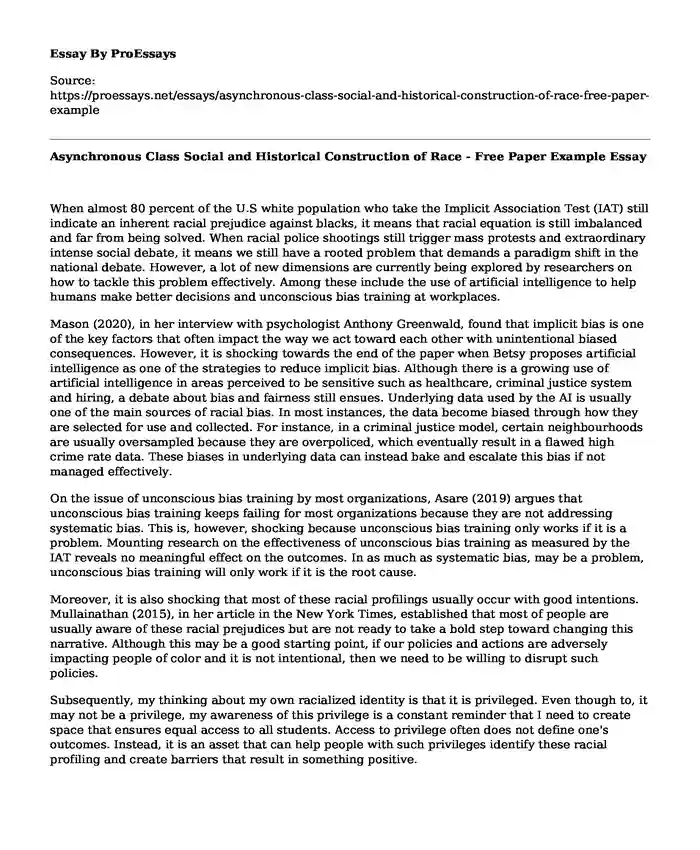When almost 80 percent of the U.S white population who take the Implicit Association Test (IAT) still indicate an inherent racial prejudice against blacks, it means that racial equation is still imbalanced and far from being solved. When racial police shootings still trigger mass protests and extraordinary intense social debate, it means we still have a rooted problem that demands a paradigm shift in the national debate. However, a lot of new dimensions are currently being explored by researchers on how to tackle this problem effectively. Among these include the use of artificial intelligence to help humans make better decisions and unconscious bias training at workplaces.
Mason (2020), in her interview with psychologist Anthony Greenwald, found that implicit bias is one of the key factors that often impact the way we act toward each other with unintentional biased consequences. However, it is shocking towards the end of the paper when Betsy proposes artificial intelligence as one of the strategies to reduce implicit bias. Although there is a growing use of artificial intelligence in areas perceived to be sensitive such as healthcare, criminal justice system and hiring, a debate about bias and fairness still ensues. Underlying data used by the AI is usually one of the main sources of racial bias. In most instances, the data become biased through how they are selected for use and collected. For instance, in a criminal justice model, certain neighbourhoods are usually oversampled because they are overpoliced, which eventually result in a flawed high crime rate data. These biases in underlying data can instead bake and escalate this bias if not managed effectively.
On the issue of unconscious bias training by most organizations, Asare (2019) argues that unconscious bias training keeps failing for most organizations because they are not addressing systematic bias. This is, however, shocking because unconscious bias training only works if it is a problem. Mounting research on the effectiveness of unconscious bias training as measured by the IAT reveals no meaningful effect on the outcomes. In as much as systematic bias, may be a problem, unconscious bias training will only work if it is the root cause.
Moreover, it is also shocking that most of these racial profilings usually occur with good intentions. Mullainathan (2015), in her article in the New York Times, established that most of people are usually aware of these racial prejudices but are not ready to take a bold step toward changing this narrative. Although this may be a good starting point, if our policies and actions are adversely impacting people of color and it is not intentional, then we need to be willing to disrupt such policies.
Subsequently, my thinking about my own racialized identity is that it is privileged. Even though to, it may not be a privilege, my awareness of this privilege is a constant reminder that I need to create space that ensures equal access to all students. Access to privilege often does not define one's outcomes. Instead, it is an asset that can help people with such privileges identify these racial profiling and create barriers that result in something positive.
Conclusion
Overall, I think assimilation toward whiteness is more to blame for our current state of racial profiling. “Assimilation” is a catchphrase that always pops up in the emotive debate over illegal immigration. Incidents from the early 20th Century highlight the impact of assimilation on race after it was formalized as a legal concept. After the Civil War, the law dictated that naturalization only applied to individuals considered free white persons and those of African nativity. During this period, black people hardly enjoyed the practical benefits of this citizenship right. Assimilation was used to legitimize racial profiling of people of color by codifying special privileges to whites. Evidently, this is the situation today. Social status is still being elevated by white assimilation, and racial passing as people of color still lack certain privileges in areas such as education, health, and the criminal justice system. Therefore the question remains whether assimilation today is true or it is just an endurance of racial boundaries.
References
Asare, J. G. (2019, December 29). Your Unconscious Bias Trainings Keep Failing Because You’re Not Addressing Systemic Bias. Forbes. https://www.forbes.com/sites/janicegassam/2020/12/29/your-unconscious-bias-trainings-keep-failing-because-youre-not-addressing-systemic-bias/#65f58e501e9d
Mason, B. (2020, June 10). Making people aware of their implicit biases doesn’t usually change minds. But here’s what does work. PBS News Hour. https://www.pbs.org/newshour/nation/making-people-aware-of-their-implicit-biases-doesnt-usually-change-minds-but-heres-what-does-work
Mullainathan, S. (2015, January 3). Racial Bias, Even When We Have Good Intentions. The New York Times. https://www.nytimes.com/2015/01/04/upshot/the-measuring-sticks-of-racial-bias-.html
Cite this page
Asynchronous Class Social and Historical Construction of Race - Free Paper Example. (2023, Dec 13). Retrieved from https://proessays.net/essays/asynchronous-class-social-and-historical-construction-of-race-free-paper-example
If you are the original author of this essay and no longer wish to have it published on the ProEssays website, please click below to request its removal:
- Crash: The Next Great Depression? TV Movie Plot Summary
- Research Paper on History of SPAM: A Key to Winning the World War II
- Essay Sample on The Use of Propaganda in Fascism
- Essay Example on Who Owns a Child? Exploring the Debate on Paternity Fraud Laws
- Research Paper on 3 Purposes of Utterance: Thematic, Speech Act, Propositional
- Essay Example on the Aftermath of War: Understanding International Conflict Expansion
- Research Paper Example on Feminist Theory: Understanding Social Justice and Equality







